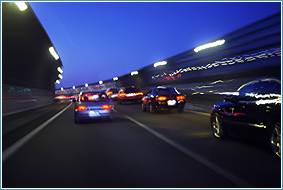Your Health :: Night Driving

At night, drivers lose the advantage of color and contrast that is available during the day. Depth perception and peripheral vision are also diminished. Studies have shown that 90% of a driver's reaction depends on vision, while some drivers over 50 years old may need twice as much light as someone in their 30s
To assure maximum visibility while driving at night:
- Align your headlights
- Ask the service technician at inspection to check the aim of your headlights. Take your vehicle to a dealer or repair shop for a headlight checkup
- Consider anti-reflective eyeglasses
- Ultra-thin film reduces internal reflections in the lenses. AR-coated glasses transmit more light than regular lenses, which improves vision at night and helps distinguish fine details during the day
- Turn your headlights on one hour before sunset, and keep them on at least one hour after sunrise
- In fog, use only low beam headlights
- Avoid glare: instead of looking at oncoming headlights, look toward the right side of the road and watch the white line marking the outside edge of the traffic line
- Also, diminish your dashboard lights and use your sun visor to reduce glare. Avoid using any other lights inside your vehicle
- Dirty headlights can reduce efficiency by as much as 90%. Clean the inside and outside of your windshield, as well as your headlights
- Use the mirror's day/night setting
- All cars have day/night interior mirrors to reduce glare from cars directly behind you. You can usually change the mirror to its "night" setting by flipping the small lever at the bottom of the mirror
- Prevent fatigue
- Ensure good ventilation inside your vehicle and take frequent refreshment breaks to give your eyes a chance to recover









